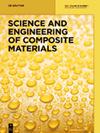粒径分布对掺补胶凝材料水泥微观结构和氯离子渗透性的影响
IF 1.6
4区 材料科学
Q3 Materials Science
引用次数: 0
摘要
摘要为了提高混合水泥中补充胶凝材料(SCMs)的抗氯离子渗透能力,本研究基于Fuller模型对胶凝组分的粒径分布进行了优化。采用精密空气分级机将硅酸盐水泥(PC)、粉煤灰(FA)和矿渣粉(GGBFS)分别划分为0 ~ 8 μm、8 ~ 30 μm、30 ~ 50 μm和50 ~ 80 μm四个粒径范围。通过9组正交试验,确定了以28天抗压强度为基准的4个范围内的最佳胶凝材料。GGBFS粒径为0 ~ 8 μm, PC粒径为8 ~ 30 μm, GGBFS粒径为30 ~ 50 μm, FA粒径为50 ~ 80 μm,得到了性能最佳的混合水泥。结果表明,基于Fuller模型的SCMs混合水泥具有更小的孔径、更强的火山灰效应和更强的氯离子结合能力,因此具有更好的微观结构和抗氯离子渗透能力。此外,本研究还为实现SCMs在混合水泥中的大量应用提供了一种新的途径。本文章由计算机程序翻译,如有差异,请以英文原文为准。
Effect of particle size distribution on microstructure and chloride permeability of blended cement with supplementary cementitious materials
Abstract In order to improve the chloride ion penetration resistance of supplementary cementitious materials (SCMs) in blended cement, this study optimizes the particle size distribution of cementitious components based on the Fuller model. Portland cement (PC), fly ash (FA), and ground granulated blast furnace slag (GGBFS) are successfully divided into four particle size ranges by precision air classifier, which are 0–8, 8–30, 30–50, and 50–80 μm, respectively. The optimum cementitious materials in four ranges based on 28-day compressive strength are determined by nine groups of orthogonal tests. The blended cement with optimal performance is obtained by GGBFS in 0–8 μm, PC in 8–30 μm, GGBFS in 30–50 μm, and FA in 50–80 μm. The results show that the blended cement with SCMs based on Fuller model have superior microstructure and chloride ion penetration resistance, which is due to their smaller pore size, a strong volcanic ash effect, and chloride ion binding ability. In addition, this research presents a novel approach for realizing the application of a large amount of SCMs in blended cement.
求助全文
通过发布文献求助,成功后即可免费获取论文全文。
去求助
来源期刊

Science and Engineering of Composite Materials
工程技术-材料科学:复合
CiteScore
3.10
自引率
5.30%
发文量
0
审稿时长
4 months
期刊介绍:
Science and Engineering of Composite Materials is a quarterly publication which provides a forum for discussion of all aspects related to the structure and performance under simulated and actual service conditions of composites. The publication covers a variety of subjects, such as macro and micro and nano structure of materials, their mechanics and nanomechanics, the interphase, physical and chemical aging, fatigue, environmental interactions, and process modeling. The interdisciplinary character of the subject as well as the possible development and use of composites for novel and specific applications receives special attention.
 求助内容:
求助内容: 应助结果提醒方式:
应助结果提醒方式:


